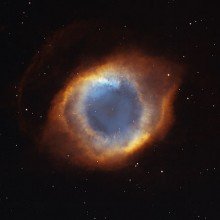I know I’ve said it before, but this really is a fantastic time of year for stargazing, and so, flushed with the success of the session on the bank holiday Monday (see my last piece), I couldn’t resist going out again the following night (August the 30th).
Completing the Messier catalogue is going to have to wait until next year, so I’ve returned to the Caldwell catalogue for inspiration. First up were galaxies C17 and C18 in the constellation of Cassiopeia. I’ve searched for these two mag 9 dwarf galaxies (both satellites of the Andromeda galaxy, and around 2.3 million light years from Earth) on a number of occasions, but they’ve always beaten me. Determination won through, though, and, despite being very faint, particularly C17, I made them both out.
Next up was C43 (about 49 million light years away in the constellation of Pegasus). Another tricky find, this is a very faint object, and, at apparent magnitude 10.5, needs a fairly large aperture scope to find.
Another object that has eluded me for some time now is the Helix nebula (C63) in Aquarius (also known as the Eye of God nebula …). Although big and, at around 700 light years away, relatively close, it never rises very high above the horizon, and so its relative difficulty is more due to atmospheric haze than anything else. It really is an amazing sight (aided by using an OIII filter on a relatively low magnification eyepiece). You can really see how it got the ‘Eye of God’ nickname.
Next up was the Turtle nebula in Hercules. Not a Caldwell object, I just happened to see from Stellarium on my phone that it was ideally placed in the west for viewing, so I thought I’d give it a go. This was a relatively easy find (certainly compared to the galaxies mentioned earlier), and it appeared very much like a planet, but fuzzier; it was very clear how the term planetary nebula seemed appropriate at the time it was coined.
Tired, and with work in the morning, I spent a little before packing up looking at some lovely binary stars: (Rasalgethi and Rho Hercules in Hercules; Izar in Bootes; and Mesarthim in Aries). Some lovely colours there (blues, blue/whites, yellows and oranges); well worth checking out.
My next session was Saturday the 10th of September. Full cloud and intermittent rain all day eventually gave way to the most amazingly clear sky, and even with a quarter moon lighting things up I was able to find Neptune and Uranus relatively easily: both small pale orbs against the background stars. Whilst it’s possible to see more distant objects, of course, I find it amazing that we can see such relatively small objects, too. To illustrate the scale, if the Earth was the size of a cherry tomato, Uranus would be an apple about 3400 metres away, and Neptune a lime just over 5000 metres away …
I spent quite a while viewing the two planets, but eventually got back to hunting down some more Caldwell objects. First up were C56 (a planetary nebula) and C62 (a galaxy about 7 million light years away) in Cetus. Both were very tricky (small, dim, and low in the sky).
Next up was the Sculptor galaxy (around 10 million light years away in the Sculptor constellation). Although very low in the sky, I could discern some detail in the galaxy: darker lines and patches. It’s quite big too!
I rounded off the evening taking in the Pleiades, Hyades, plus M37, 36 and 38 star clusters, plus the Veil, Crab (very dim), and Flaming Star nebulæ (alas, not much nebulosity on show in the latter), then spent a little while just staring at the sky with binoculars and with the naked eye; amazed at the spectacle; the Milky Way was incredible overhead!
With dew building up on the scope, and the time being 2am, I decided, very reluctantly, to turn in …
Incidentally, out of the 65 or so Caldwell objects observable from the UK, my count is now up to 44!
What’s up?
The Moon will be full on the 16th, and rising in the early evening, so deep sky observations will have to wait for now. If you are out and about after dark, though, a few doubles, such as Almaak in Andromeda, Mesarthim in Aries, and Rasalgethi in Hercules are well worth a look.
Neptune and Uranus are very well placed at the moment, and are possible in 10×50 binoculars (as tiny pin-points), but telescopes will reveal the planetary shape.
Clear skies!
Kevin Quinn is an amateur astronomer based in Cerne Abbas. He is the proud owner of a ten-inch reflector, a small refractor, a case of eyepieces, and a couple of pairs of binoculars. He tweets via @CerneAstro, and blogs (occasionally) via theastroguy.wordpress.com.
©Kevin Quinn







